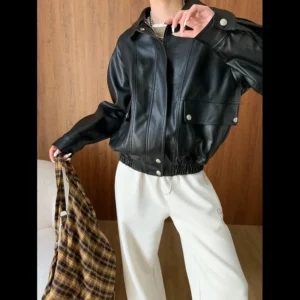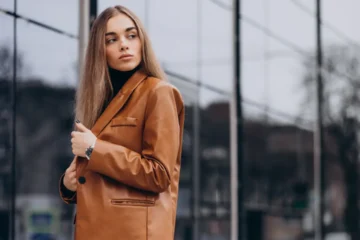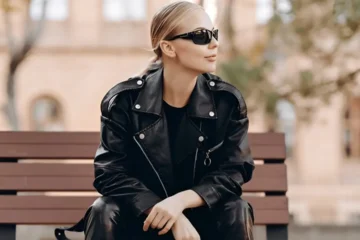When you decide to invest in a premium leather jacket, you’re buying more than just outerwear — you’re selecting a piece that can define your style, endure over years, and become more special with age. Whether you’re browsing “Men’s Leather Jacket”, eyeing the latest “Leather Bomber Jacket”, considering a “Schott Leather Jacket”, or picking something elegant for women, understanding what makes a leather jacket truly premium will help you make a confident decision. This guide (brought to you by vadeblanc) walks you through detailed features, styles, types, fit, and care so you end up with the best leather jacket for your needs.
Table of Contents
- What Defines a Premium Leather Jacket
- Types of Leather & Materials
- Full‑grain, top‑grain, genuine, and more
- Other materials: lining, finishes, hardware
- Styles & Designs: Which One’s for You?
- Classic bomber, biker, moto, aviator, racer
- Design details & garment trends
- Fit, Size, and Comfort Considerations
- Body type, layering, movement
- Men vs Women: differences in cut
- Hardware, Stitching, and Construction Quality
- Zippers, snaps, seams
- Lining, collar, reinforcements
- Texture, Color, and Finish
- How leather ages (patina, wear)
- Dyes, finishes, coatings
- Brand & Origin: Why It Matters
- Heritage brands (e.g. Schott) vs fashion brands (e.g. Zara)
- Ethical sourcing, country of manufacture
- Price vs Value: What You’re Really Paying For
- How to assess cost
- When spending more makes sense
- Care & Maintenance Tips for Longevity
- Frequently Asked Questions (FAQs)
- Conclusion
1. What Defines a Premium Leather Jacket
A premium leather jacket isn’t just about how it looks on the outside. There are several qualities that differentiate something that’s just “nice” from something that feels and performs like an investment:
- Durability — Will the jacket survive regular wear, weather, movement, and still look good after a few years?
- Material authenticity — Real leather, good quality hides, true grain rather than artificial coatings.
- Craftsmanship — Seams, lining, details like zippers and hardware should be built to last.
- Fit and comfort — A jacket that feels restrictive will end up in the back of the closet; one that fits well becomes a go‑to.
- Aging well — Premium leather develops character over time: softening, gentle creases, patina, etc.

2. Types of Leather & Materials
Types of Leather
Knowing different leather types helps you understand what you can expect in feel, durability, and price:
Other Materials & Components
- Lining materials: good jackets often use satin, silk blends, viscose, or quilted cotton. These help with comfort, insulation, and allow putting on/removing the jacket easily.
- Hardware: zippers (good metal or branded ones like YKK), quality snaps, metal hardware rather than cheap plastic. These are frequent failure points.
- Finish and coatings: Aniline or semi-aniline finishes, waxed or oiled surfaces, protective topcoats—these influence look, water resistance, aging.
3. Styles & Designs: Which One’s for You?
Style plays a big role since different designs suit different personalities, climates, and use cases.
Popular Styles
- Bomber Jacket (and Men’s Leather Bomber Jacket) — short, often with ribbed hems and cuffs. Good casual choice; versatile.
- Biker / Moto Jacket — asymmetrical zip, pointed lapels, wider collars; often more aggressive style.
- Aviator / Flight Jacket — larger collars, shearling or fur lining; more rugged or vintage vibe.
- Racer Jacket — sleek, minimal, often zip‑up, no large lapels. Great for layering or for a clean look.
- Fashion / Trend‑Driven Styles e.g. what you might see from “Leather Jacket Mens Zara” stores: lighter styles, more color options, sometimes slimmer cuts.
Design Details to Consider
- Collar style: lapel, stand, snap, fur or shearling.
- Pocket layout: zip pockets, flap pockets, interior pockets, how they align.
- Venting and comfort in movement: underarm gussets, stretch panels.
- Color: classic black, deep brown, tan, etc.; maybe dyed colours for fashion statements.
4. Fit, Size, and Comfort Considerations
Even the best leather is wasted if the fit is off.
Fit Essentials
- Shoulder fit: Seams should align with your natural shoulder; otherwise, the silhouette looks sloppy or restrictive.
- Sleeve length: Should end at your wrist bone when arms are relaxed. Too long or too short looks off.
- Torso length & cut: Depending on style (bomber tends to be shorter; moto/racer may go a bit longer). For women, waist taper, and curves need to be considered in cut.
- Layering allowance: If you’ll wear thick sweaters underneath, ensure enough room in chest/back.
Gender Differences
- Women’s leather jacket cuts often include more shaping, shorter waists, narrower shoulders, perhaps different collar or detailing.
- Men’s jackets may prioritize broader shoulders and more room in the torso.
5. Hardware, Stitching, and Construction Quality
Stitching & Seams
- Even, tight stitches; no loose threads or skipped stitches.
- Reinforced stitching at stress points: elbows, underarms, pockets. Bar‑tacks or double stitching.
- Seam types: flat‑felled, French seams, or other methods that encase raw edges and prevent fraying.
Hardware
- Zippers: metal ones, often made by reputable brands (YKK, etc.). Must move smoothly without catching.
- Snaps, buckles, buttons: they should be secure, rust‑resistant, and proportional.
Lining & Interior Construction
- Quality lining improves comfort and helps with durability (protects interior from sweat, friction).
- Check for interior pockets, clean finishing inside, no rough edges.
6. Texture, Color, and Finish
- Texture: Natural grain has texture and small imperfections—these are desirable in full‑grain / top‑grain leather. Over‑processing leads to plastic‑like texture.
- Colour uniformity: Even dye penetration, consistent color throughout; edges should match. Flaking or uneven color is a red flag.
- Finish / patina: Some leathers shine; others are matte. Some finishes age better, develop patina (richness from wear). If you like character as they break in, full‑grain with minimal surface coating is better.
7. Brand & Origin: Why It Matters
- Heritage brands like Schott are known for decades of leather expertise. They tend to maintain quality standards.
- Fashion brands may follow trends, might use lower quality leather to hit price points more affordably (“Leather Jacket Mens Zara” is a useful reference: stylish but often more fashion‑fast and less durable).
- Country of manufacture often reflects labour and quality standards: Italy, USA, UK, etc.
- Ethical sourcing, environment-friendly tanning, transparent supply chains are more common in premium offerings.

8. Price vs Value: What You’re Really Paying For
Spending more on a premium leather jacket is justifiable if:
- The leather grade is high (full‑grain or high top‑grain).
- The hardware and stitching are of high quality.
- The design is timeless, or fits your style so you’ll wear it often.
- It is built to last: the more use + care, the more value you recoup.
On the other hand, cheaper jackets may look good initially but degrade faster, lose shape, hardware breaks, color fades. So calculate cost per use: a more expensive jacket that you wear regularly might end up cheaper per wear.
9. Care & Maintenance Tips for Longevity
To make your premium leather jacket serve you well:
- Clean it properly: use damp cloth; avoid soaking. Specialized leather cleaners.
- Condition: use leather conditioner or oils meant for the leather type. Keeps it supple.
- Avoid exposure: too much sunlight, water, heat; hang it on broad, padded hangers.
- Store carefully: breathable cover; avoid plastic bags that trap moisture.
- Fix small issues early: loose stitches, small tears, hardware that becomes loose.
10. Frequently Asked Questions (FAQs)
Q1: Is a “Leather Bomber Jacket” always more durable than other styles?
A: Not necessarily. Style type (bomber, biker, etc.) relates more to silhouette and design. Durability depends on leather quality, construction, hardware, and stitching. A well‑made racer or moto jacket can outlast a poorly made bomber.
Q2: How can I tell if a jacket labelled “genuine leather” is really premium?
A: Look past the label:
- Feel the leather: premium leather feels supple yet firm, with natural texture.
- Smell it: real leather has a rich, earthy scent; fake/synthetic often smells chemical.
- Inspect stitching & hardware: quality zippers, even tight stitches, no cheap plastic hardware.
- Test how the leather ages: will it develop patina? Full‑grain will; lower grades often flake or crack.
Q3: Should I choose full‑grain or top‑grain leather?
A: If budget allows and you want the most durable, highest quality, go with full‑grain. If you prefer a smoother, more uniform finish or lower cost, top‑grain is a strong compromise.
Q4: How should a leather jacket fit differently for men vs women?
A: Women’s cuts often include more shaping: tapered waists, narrower shoulders, curved cuts. Men’s jackets often have broader shoulders and straighter cuts. Trying on with intended layers helps.
Q5: Are fashion brands like Zara bad choices?
A: Not necessarily bad—if your priority is style and current trend, they offer good value. But they often use lower grade leather or thinner hides, simplified hardware, and may not age as well. If you want long‑term durability and “best leather jackets for men” quality, looking toward heritage brands or higher‑end manufacturers is wiser.
Q6: How much should I expect to spend on a truly premium leather jacket?
A: Price depends on brand, leather grade, finishing, hardware, and where it’s made. For premium full‑grain jackets with good hardware, expect to invest significantly more than “fast fashion” pieces. But consider it a long‑term piece.
11. Conclusion
A premium leather jacket is more than just outerwear — it’s an expression of style, craftsmanship, and value. Picking the right one means paying attention to the leather type, construction, hardware, fit, and finishing touches. Whether you want a rugged biker jacket, a sleek racer back, or a classic bomber, what matters most is that the jacket fits you well, feels right, and is built to last.
If you’re in the market for something special that will become a staple in your wardrobe for years, apply these guidelines. The right pick will reward you with style, comfort, and durability. Enjoy the hunt — when you find the perfect jacket, it’s worth every effort.



